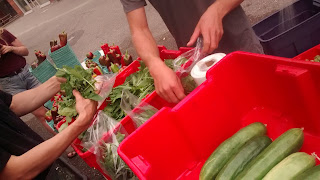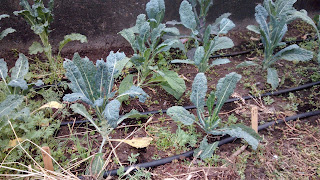Amid cloudy skies, Sep.5, 2017 marked our first day back at our
(already!) last semester of our Agroecosystems Management class, and it won’t
be long before time will magically fly by faster each week than the week
before, especially now with our 3 hour weekly class!
We agsembled together and then had our quick morning walk-about along
the terraces and:
- We saw that the lettuce plants were germinating well.
- We sampled the swiss chard and came to agreement that it had become too bitter to market, so we will need to take it out.
- We came across one of our kale trials and noticed that there was inconsistent growth among the kale plants, including the kale plants that were within the same variety (as visible by the varied heights) within the trial. We hypothesized that the growth inconsistency may be due to the effect of variance in light exposure/shading of the kale plants, as kale grows better under full-sun than in shaded areas.
 |
| Kale trial location |
 |
| Kale trial- note the variation in growth |
We had encountered a similar case of inconsistency of colour with our rye grass that was previously planted near the same area where the kale trial was planted. Some reasons proposed for the observed differences of colour included inconsistent application of compost/soil amendments, differences in soil drainage rates, or temperature effects from the surrounding concrete.
Maybe its an unlucky coincidence, or the effect of some unaccounted physical or chemical factors at the site. This is one of the reasons why record keeping is so important, as past records can provide useful clues or information that can help guide our future decisions.
- We also checked on the squash plants and noticed that it had a case of powdery mildew, which had developed on some of the leaves but that had negligible effect on our harvest.
 |
| Squash leaves affected by powdery mildew |
After the walk-about, we geared ourselves up to jump back into market
harvest mode.
Harvesting:
 |
 |
 |
| Peppers! |
 |
| Squash(left) and arugula(right) |
 |
| Hakurei Turnip |
 |
| Cucumber |
 |
| Nasturtium leaves and flowers |
Processing:
 |
| Washing Turnip |
 |
| Leek Trimming |
 |
| Bagging salad greens |
Our harvest included Hakurei turnip, squash, cucumber, basil,
nasturtiums, leek, peppers, and our feature of the week: Shisho.
 |
| Shisho |
Shisho is a unique tasting leaf with an atypical blend of flavours…if you could, imagine tasting a mix of mint, basil, citrus, or even cilantro at the same time! It can be a challenge to not be taken aback by the taste, but also to learn that it can be used as a flavourful herb to add to a wide range of dishes, whether its meat, seafood, vegetable, or soup, or even as a topping.
A few of us also collected both quantitative and qualitative data for
one of our kale trial plots (we have three replicates in total across the terraces). For each kale trial, each
variety of kale plant is planted in a chevron pattern. The data samples are
taken from the large outer leaves of the kale plants.
Kale trial:
 |
For quantitative data we:
-Kept track of number of plants
-Counted and weighed the leaves
-And measured the height up to the tip of the youngest leaf, and took the average of the measured heights.
For Qualitative data (3-step process) we:
1. Did a taste test: describe the flavor(blandness, sweetness, bitterness); texture (rough, smooth, tough)
2. Noted pest damage (eg. aphid density, caterpillar damage…)
3. Concluded whether the kale variety was marketable
1. Did a taste test: describe the flavor(blandness, sweetness, bitterness); texture (rough, smooth, tough)
2. Noted pest damage (eg. aphid density, caterpillar damage…)
3. Concluded whether the kale variety was marketable
We also learned that the Kwantlen St. Market has been relocated to
Minoru Plaza , conveniently located just outside the Richmond Public Library and Cultural
Centre.
This location change has been positive overall so far. This is the
second location change that has occurred so far, and it has been interesting to
see the effects of location change on the market and how much the market has
grown. Starting off at the parking lot at the KPU Richmond Campus, then shifting
to in front of the terraces, and moving just recently to the plaza… each place had its pros
and cons, to the growers, vendors, and consumers in terms of accessibility, convenience, and sales. And those pros and cons may differ quite significantly between the three parties, so it is important to consider the effects on all three.
The Agroecosystems Management course has enabled us to experience how agriculture is affected by not only challenges on-farm but also challenges off-farm; how with continued persistence, perseverance, and supportive collaboration, we can devise and test different solutions to help adapt to those challenges; how the process is a dynamic one that comes with both ups and downs; and how each result can serve as a learning opportunity.
With regards to our newest location change, customer traffic has been much better at the Kwantlen St. Market at the Minoru plaza, especially compared to the traffic we had at our terrace location. This new location, with its more accessible (and still free!) parking and greater access to the public community, is helping expand the market with a much greater number of vendors and also generating more sales.
The Agroecosystems Management course has enabled us to experience how agriculture is affected by not only challenges on-farm but also challenges off-farm; how with continued persistence, perseverance, and supportive collaboration, we can devise and test different solutions to help adapt to those challenges; how the process is a dynamic one that comes with both ups and downs; and how each result can serve as a learning opportunity.
With regards to our newest location change, customer traffic has been much better at the Kwantlen St. Market at the Minoru plaza, especially compared to the traffic we had at our terrace location. This new location, with its more accessible (and still free!) parking and greater access to the public community, is helping expand the market with a much greater number of vendors and also generating more sales.
 |
| Free parking |
Local vendors:
The market runs every Tuesday from 12-4pm until
October 31 at this new location. Come visit us and discover our local vendors,
learn about our produce, and maybe you will stumble upon a new Shisho of the
day or some new treasure every now and then!
 |










No comments:
Post a Comment